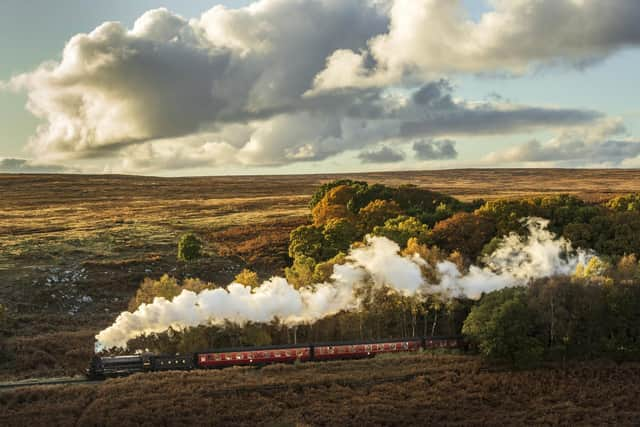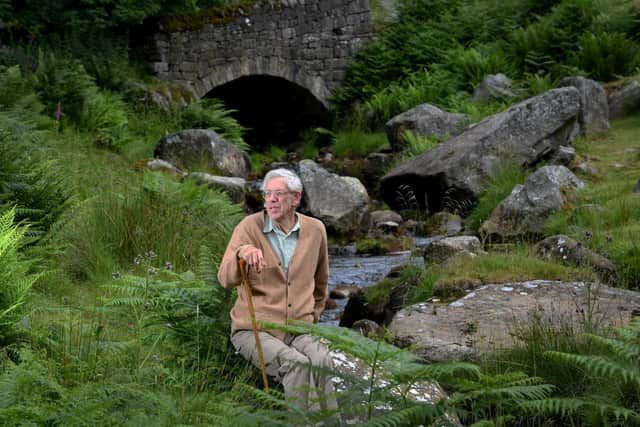The railways of the Yorkshire Dales - new book captures how they have changed from late 1950s to present day
There is something romantic, gloriously nostalgic, about a steam engine. That whiff of grey vapour, a hint of oil, the sense of impact, whatever the size may be – a great gleaming giant like the Mallard, gliding majestically on a main line, or a tiny tank puffer that has seldom been out of the sidings, and which has devoted its life to humbly shunting trucks.
Diesel and electric units somehow just don’t have that same appeal, and they fail to create that same magic. But both steam and diesel played a huge part in forming Yorkshire, transporting passengers and heavy goods, and now a new book, by David Joy and Gavin Morrison, looks specifically at the lines of the Dales that were closed and lifted, the rails sold for scrap, and others which somehow survived the “Beeching axe” of the 1960s.
Advertisement
Hide AdAdvertisement
Hide AdIt’s a fascinating glimpse of an era that has all but vanished, and which survives today in the “heritage railways” such as the Worth Valley line, and the North York Moors Railway.


Between them, David and Gavin have produced more than one hundred books on railway themes – David is the writer (he began his career in journalism on The Yorkshire Post, and went on to be a distinguished editor of The Dalesman magazine for many years) and Gavin is the acclaimed man with the camera, whose collection of photographs on and about rail is second to none.
He’s based in Skipton and David lives in Hebden, near Grassington (his family have worked the land hereabouts for many centuries). The pair of collaborators have a close relationship. Ideas bounced between them, and the end product, Railways and The Dales, is an entertaining inter-weave between the illustrations and the printed word.
David asked Gavin to go to his overflowing archive (there are around 200,000 pictures in all) and to select a couple of hundred of them which evoked the glory days of rail transport in this idyllic part of Yorkshire.


Advertisement
Hide AdAdvertisement
Hide Ad“That wasn’t asking too much, was it?” David chuckles, “not too much of a task at all. But in all seriousness, I have a very deep admiration for Gavin’s skills, and that goes back for forty years and more. His work is such an abundance of riches. He is as obsessed with the railways as I am, and we first encountered each other when British Rail announced their intention to close the rail route from Settle to Carlisle.
He continues: “That was 1981, and there was an almost instant demand for books on and about this famed and much-loved stretch of the network. As illustrator, Gavin was clearly the man of choice... His skill is he shows trains in the landscape, and gives them a sense of place and time, they aren’t merely photos of locos.”
For this project, the pair hardly met at all, largely because of the circumstances of the past two years.David, 79, says: “Gavin’s digital database is simply incredible, and he is so skilled and knowledgeable that he can usually find a specific shot within a few minutes – and, believe me, he’s had quite a few challenging questions and requests from me as the years have gone by. We live in the digital age, for good or ill, and in this case, thank heavens, for the good.”
David’s passion for the railways began as a boy, aged eight or nine, living in York. “I was so lucky in that I had a very long-suffering mother, who would accompany me on trips just outside the city, but next to the line, so that I could see the great engines that were hauling services like The Elizabethan or The Flying Scotsman, whizz past, and if you were lucky you’d get a whistle of acknowledgement as well. Steam is an emotion, and once experienced, it never deserts you.”
Advertisement
Hide AdAdvertisement
Hide AdWatching turned to getting involved when he went to live in Grassington, which then had its own station and sidings. The youngster became friendly with the local stationmaster, who was also the porter, and there were many occasions when he was allowed onto the footplate of an engine shunting and pulling freight – passenger traffic had ceased in the autumn of 1930.
“It was always a thrill, especially since the track wasn’t in the best of repair”, he says, “and it was far more of a bounce on the footplate, rather than a smooth motion. And it was also, shall we say, rather naughty, but we were rather remote from authority.”
David believes that the national love of steam was galvanised when the infamous Dr. Beeching was ordered by the government of the day to propose a plan that would rationalise the nation’s railway system. “One day, the lines were there and, in many cases, by the end of a few months, they were not. And some of cuts were – and still are – inexplicable, totally irrational.”
Such as? He doesn’t hesitate. “Well, just a few that spring to mind are that relatively short stretch from Malton to Pickering. What sense was there in closing that link? Or the line from Scarborough to Whitby. What a glorious tourist attracting that would be today. Then there’s the vanished Skipton to Colne link.
Advertisement
Hide AdAdvertisement
Hide Ad“And the biggest blunder of all, I think, was destroying the track from the main East Coast main line through to Ripon and Harrogate. That left a great city without a station – unbelievable. And please don’t get me going on the destruction of that fine old Victorian station building in Harrogate itself. It was wantonly torn down to make way for that concrete monstrosity of today. There are so many examples of cultural and social vandalism out there.
“There is a common theme that runs though all of this, and that is that many town planners and modernisers, people required to put in a future strategy, usually fail to consider future requirements. Ones that will impact in twenty years, and not two or three.”
Saving the Settle to Carlisle route was, however, a notable triumph – not only for commuters but the many thousands of tourists that it attracts. David was one of those who protested – constantly and very loudly. He was also one of the twenty-thousand-plus signatures on the petition to save the line, which is now one of the most-photographed attractions in all the UK.
He is “delighted” that the media have rediscovered the allure of the railway, although he emphasises that for all the lines that run through spectacular landscapes, there are as many which are (or were) flanked by heavy industry.
Advertisement
Hide AdAdvertisement
Hide AdIn the book, he enjoys nothing more than weaving little nuggets of joy into the commentary on Gavin’s photographs. Why, for example, were there often delays to the Skipton to Grassington goods service? There was seldom more than one wagon to pull – and there was only one train a day. Punctuality was the last concern of the driver, and what he might have for his dinner that night took precedence. In season, he’d stop somewhere, and pick a good bag-full of mushrooms.
“It’s a picture of a vanished world”, says David, “but the lesson from all those cuts is simple – you never know what you’ll miss until it has gone!”
Railways and The Dales is published by Great Northern Books.
